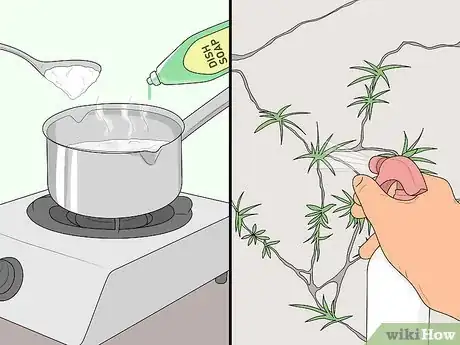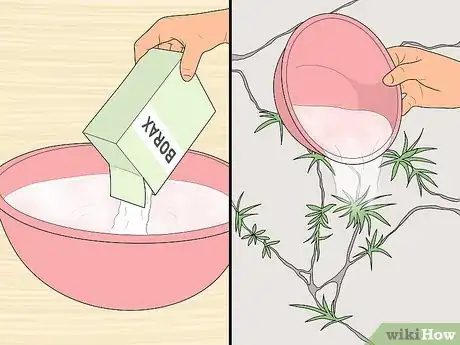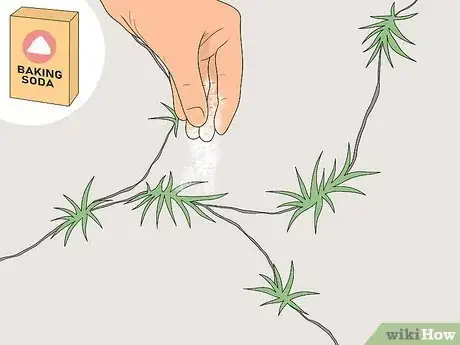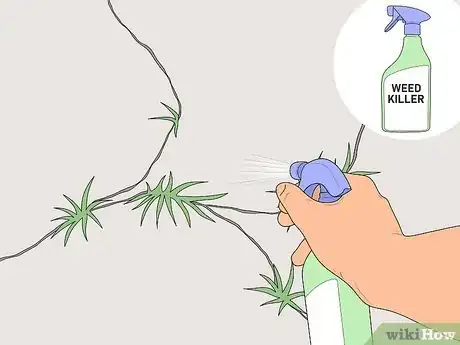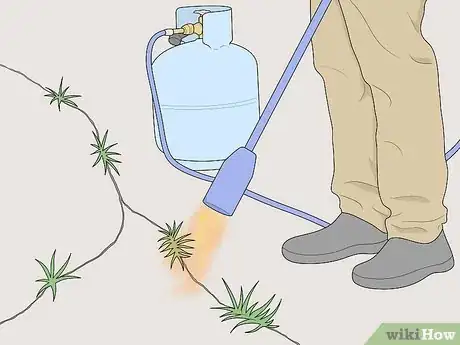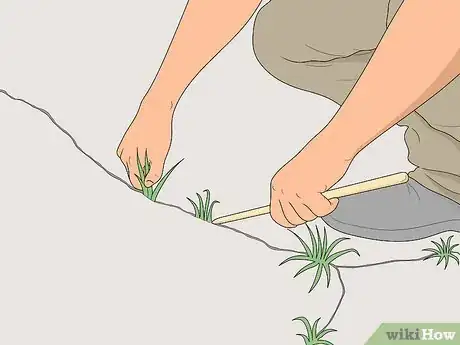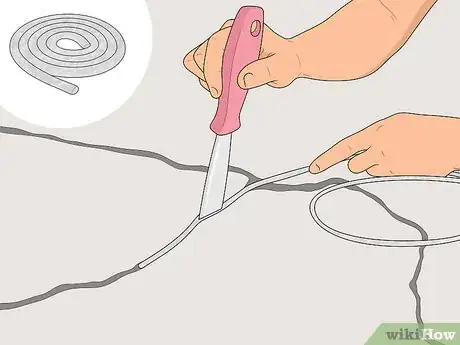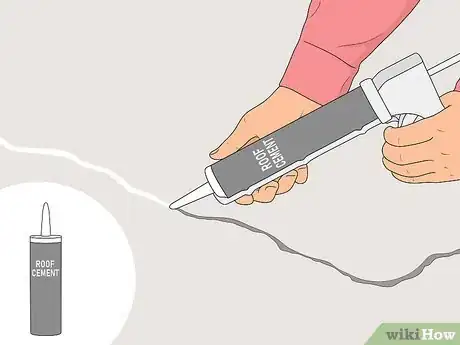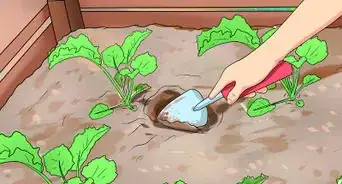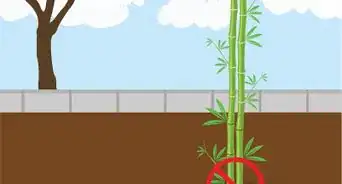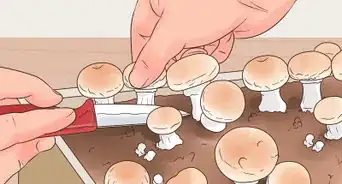This article was co-authored by Scott Johnson. Scott Johnson is the Owner and Lead Design Consultant for Concrete Creations, Inc., an award-winning landscape and design company based in the San Diego, California metro area. He has over 30 years of experience in the pool and landscape construction industry and specializes in large estate outdoor environment construction projects. His work has been featured in San Diego Home & Garden Magazine and on Pool Kings TV Show. He earned a BS degree in Construction Management with an emphasis in Architecture and CAD design from Northern Arizona University.
There are 17 references cited in this article, which can be found at the bottom of the page.
This article has been viewed 47,513 times.
Weeds are invasive plants that can overrun your desirable plants and cause damage to housing and yard materials. While some weeds are fairly easy to kill, they can be a bit tricky to remove when they sprout up through the cracks in your driveway, walkways, porch, or pavers. To kill the weeds growing in these cracks, you can use a variety of different home remedies or purchase a commercially-available weed killing liquid or device. You can also remove weeds from cracks by digging up the plants and their roots before sealing the cracks with concrete or gravel.
Steps
Killing Weeds with Home Remedies
-
1Pour boiling water over the cracks to kill weeds safely. Bring a large pot of water to a boil on the stove. Then, carefully pour the boiling water over the leaves and stems of the weeds, as well as in the cracks surrounding the base of the plants.[1]
- The heat from the water will cause the plants to start to wilt immediately, and will kill the roots over the following days or weeks.
- Boiling water is a great option because it easily gets into the cracks and doesn’t leave harmful residue in the soil.
- This method is generally most effective on young weeds.[2]
-
2Spray a salt and dish soap solution on the weeds to kill them. Dissolve 1 part table salt or rock salt to 8 parts of hot water. Then, stir in a quarter-sized squirt of dish soap and pour the solution into a spray bottle. Spray the solution over the weeds carefully and try to avoid getting any on nearby soil, plants, or pavement to prevent damage.[3]
- Repeat this process every few weeks as needed until the weeds have died and stopped sprouting.
- The salt and dish soap solution can discolor and erode cement and kill the surrounding plants.
- For a quick and easy option, sprinkle rock salt or table salt on the weeds to kill them. This is less effective for stubborn weeds, though.[4]
Advertisement -
3Use white vinegar to kill the weeds growing in cracks. Pour white vinegar into a spray bottle and douse the weeds with it. You can also simply pour the vinegar directly from the bottle onto the weeds.[5]
- Most regular white vinegar is about 5% acetic acid and will get the job done. However, for stubborn weeds, you may need to get horticultural vinegar that's 20% acetic acid. Horticultural vinegar is available at most gardening stores.
- Adding a quarter-sized squirt of dish soap to the vinegar may make it more effective.[6]
-
4Apply a Borax solution to remove unwanted weeds from cracks. Mix 10 ounces (280 g) of Borax with 2.5 gallons (9.5 L) of water in a large bowl. Then, apply the solution directly to the unwanted weeds and into the cracks around the weeds. You can use a spray bottle to apply the solution or pour it directly onto the plants from the bowl.[7]
- Borax can irritate your skin, so you may want to wear gloves when handling the solution.
-
5Sprinkle baking soda into the cracks for a natural way to kill the weeds. Sprinkle as much baking soda as you need to cover the tops of the weeds. If you spilled any baking soda around the cracks, use your hands or a brush to sweep it into the cracks so that none is wasted. Repeat this process every 4 to 6 weeks until the weeds are gone.[8]
- Apply baking soda in the spring and fall to new, young weeds for the best results.
Using Commercial Weed Killers
-
1Pour a liquid chemical weed killer over the weeds to remove them. Purchase an all-purpose weed killer, or choose one specifically formulated for the type of weeds that you're dealing with. Follow the instructions on the label to apply the liquid over the weeds. For easier application, you can dilute some concentrated herbicides with water in a spray bottle. Check the instructions to see how to dilute the liquid and how much to spray on the weeds.[9]
- If the weed killer you’re using contains chemicals that are harmful to humans, wear protective glasses, long-sleeves, and gloves to protect your skin and eyes from exposure.
- It takes about 2 weeks for commercial liquid weed killers to kill off the weeds.
-
2Torch weeds with a flame-weeder to get rid of them immediately. Follow the instructions for your specific device to turn on the flame-weeder and let it heat up. Then, pass the torch flame over the weeds in the cracks briefly to damage the cell structure of the weeds without actually catching them on fire. Don’t allow the flames to touch the tops of the weeds.[10]
- You may need to apply heat to the area a few times to ensure that the roots are dead and won’t re-sprout.[11]
- Flame-weeders are available online and at many garden supply stores. You can also use an ordinary propane torch.
- Avoid using a flame-weeder near flammable materials like wooden decking or dry grass.
-
3Apply heat directly on the weeds to kill them with a weed steamer. Add water to the steamer and turn it on so the water starts to heat up. Then, hold the steamer over the weeds and press down the designated button for about 5 seconds to release the steam onto the weeds. Repeat this process over all the weeds you want to remove.[12]
Digging up Weeds and Sealing the Cracks
-
1Scoop the weeds and roots out of the cracks with a stake. Using a garden stake, screwdriver, or similarly shaped object, dig up under the weeds and scrape inside the cracks until all the weeds and their roots have been removed. Repeat this process in all the cracks until all of them are clear and only the dirt remains.[15]
- It may be helpful to spray the cracks with a hose or pressure washer to loosen the dirt and make the weeds easier to scrape out.[16]
-
2Use a pressure washer to remove the dirt and any lingering roots. Once all the weeds are removed, spray the cracks directly with a pressure washer. This will help lift out any dirt remaining in the cracks, as well as any weed roots that you weren’t able to reach.[17]
-
3Insert a foam caulking backer rod to fill the gaps or cracks. Measure the length of gaps or cracks in the cement where you removed the weeds. Using a box cutter or knife, cut the foam caulking backer rod to fit the length of the cracks. Then, place the foam into the cracks and press it down until it’s wedged securely inside.[18]
- Foam caulking backer rods are bendable and come in a variety of sizes at most home improvement stores, so you should be able to find a size that will fit in the cement cracks.
- Some large gaps in concrete are left on purpose to allow the concrete to expand and contract as needed to prevent cracking. The foam allows the concrete to continue to contract while filling the gap to prevent weeds from growing.
-
4Apply roofing cement in the cracks to seal them and prevent regrowth. Remove the cap on the end of the roofing cement nozzle. Place the bottle into an epoxy or roofing cement dispenser. Place the nozzle into the crack in the cement and press down on the dispenser handle to start dispensing the cement into the cracks. Follow the cracks with the nozzle to line them with roofing cement and fill them in.[19]
- You can also use epoxy or blacktop filler instead of roofing cement to seal the cracks. However, blacktop filler may not be as durable in the long run as roofing cement or epoxy.[20]
-
5Let the cement or epoxy dry for 72 hours before driving or walking on it. To allow the roofing cement or epoxy to dry completely, avoid walking or driving over it for at least 72 hours.[21] Drying times may vary depending on the specific product you’re using, however, so check the label to make sure.
- The roofing cement or epoxy will likely dry on the surface within 24 hours, but may take 72 hours to completely cure.
-
6Fill the cracks with sand or gravel for a less permanent solution. If you want to prevent the weeds from growing back but you don’t want to permanently fill them with roofing cement or epoxy, try packing the gaps with sand or gravel. Pour the sand or gravel into the cracks, pressing it down until it’s tightly packed. Repeat this process until all the cracks or gaps are filled.
- Because sand and gravel can come loose over time, you may need to repack the gaps and cracks periodically to keep them filled.
Expert Q&A
-
QuestionWhy do weeds grow in between my pavers?
 Scott JohnsonScott Johnson is the Owner and Lead Design Consultant for Concrete Creations, Inc., an award-winning landscape and design company based in the San Diego, California metro area. He has over 30 years of experience in the pool and landscape construction industry and specializes in large estate outdoor environment construction projects. His work has been featured in San Diego Home & Garden Magazine and on Pool Kings TV Show. He earned a BS degree in Construction Management with an emphasis in Architecture and CAD design from Northern Arizona University.
Scott JohnsonScott Johnson is the Owner and Lead Design Consultant for Concrete Creations, Inc., an award-winning landscape and design company based in the San Diego, California metro area. He has over 30 years of experience in the pool and landscape construction industry and specializes in large estate outdoor environment construction projects. His work has been featured in San Diego Home & Garden Magazine and on Pool Kings TV Show. He earned a BS degree in Construction Management with an emphasis in Architecture and CAD design from Northern Arizona University.
Landscape & Design Consultant If your pavers aren't sealed, water can seep into the cracks and go down into the sandy layer below. This is where the weeds grow, so the trick is to seal this area. You can remove the weeds by hand, powerwash the pavers, and then seal the pavers with a sealant to keep weeds from showing up.
If your pavers aren't sealed, water can seep into the cracks and go down into the sandy layer below. This is where the weeds grow, so the trick is to seal this area. You can remove the weeds by hand, powerwash the pavers, and then seal the pavers with a sealant to keep weeds from showing up.
Warnings
- Always wear protective gloves and eyewear when you’re handling harsh chemicals.⧼thumbs_response⧽
- Keep both flame-weeders and weed steamers away from flammable materials. In addition, avoid coming into contact with the flame or steam, as both of these can severely burn your skin.⧼thumbs_response⧽
References
- ↑ https://www.treehugger.com/lawn-garden/homemade-herbicide-kill-weeds-without-killing-earth.html
- ↑ https://www.goodhousekeeping.com/home/gardening/advice/g777/homemade-weed-killers/?slide=3
- ↑ https://www.treehugger.com/lawn-garden/homemade-herbicide-kill-weeds-without-killing-earth.html
- ↑ https://www.goodhousekeeping.com/home/gardening/advice/g777/homemade-weed-killers/?slide=4
- ↑ https://www.goodhousekeeping.com/home/gardening/advice/g777/homemade-weed-killers/?slide=7
- ↑ https://www.treehugger.com/lawn-garden/homemade-herbicide-kill-weeds-without-killing-earth.html
- ↑ https://www.treehugger.com/lawn-garden/homemade-herbicide-kill-weeds-without-killing-earth.html
- ↑ https://dengarden.com/gardening/Vinegar-Weed-Killer
- ↑ http://howtogardenlawn.com/how-to-kill-weeds-in-your-lawn-weed-killer-3-easy-methods/
- ↑ https://www.uvm.edu/vtvegandberry/factsheets/flameweeding.html
- ↑ https://www.treehugger.com/lawn-garden/homemade-herbicide-kill-weeds-without-killing-earth.html
- ↑ https://youtu.be/YJrA59A7G2I?t=9
- ↑ https://youtu.be/YJrA59A7G2I?t=37
- ↑ https://youtu.be/rwiojxoc55Y?t=8
- ↑ https://youtu.be/-0yL-rzB8W4?t=15
- ↑ https://youtu.be/U3fLCT75Gso?t=53
- ↑ https://youtu.be/U3fLCT75Gso?t=65
- ↑ https://youtu.be/-0yL-rzB8W4?t=82
- ↑ https://youtu.be/U3fLCT75Gso?t=92
- ↑ https://youtu.be/U3fLCT75Gso?t=134
- ↑ https://www.maverickcomposites.com/blogs/news/epoxy-resin-cure-at-us
About This Article
In many cases, you can get rid of weeds in cracks using simple home remedies. For a quick and safe option, boil water and pour it over the weeds. Make sure you get some of the water into the cracks around the weeds so it soaks into the roots. You can also try spraying the weeds with a solution of 1 part salt and 8 parts hot water. You’ll need to repeat this treatment every few weeks until the weeds stop growing back. Pouring white vinegar, baking soda, or a solution of water and borax over the weeds will also do the trick. If the weeds are really stubborn, try a commercial weed killer. This may take up to 2 weeks to work. Follow the instructions and any precautions on the package. Once the weeds are dead, pull them up and seal the cracks with roofing cement to keep them from coming back.

